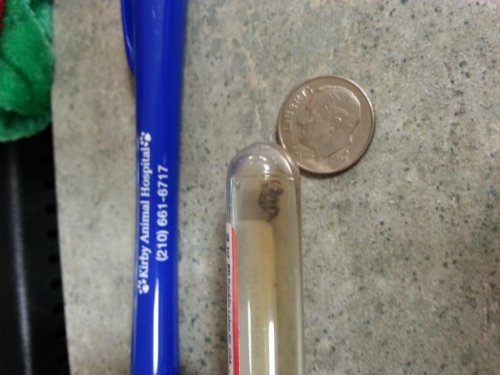jajeanpierre
Chameleon Enthusiast
I lost a baby quad quad today to lung worms. He had been gaining weight and eating well. He was just starting to drop a tiny bit of weight when he crashed.
I got him in to the vet, but he died there.
I helped her with the necropsy and we found a live worm floating in the thoracic or abdominal cavity. The biggest surprise was the huge worms that were in the lungs and that had pierced through the lungs.
The lung worms were dead and looked like three (or was if four?) perfectly formed little springs. Imagine wrapping a wire around a pencil two and a half times--that's what they looked like. They even had some spring to them if you touched them. Really creepy. They seem to have lost that spring-like form in the preserving solution.
I did take some pictures of them in the vial. All the parasites, including his external parasites, are being sent to a lab in Miami that specializes in tropical parasites.
I need some advice on how to deal with the cages. I neglected to ask the vet--which I will do tomorrow.
The dead chameleon was housed with two other same-sized females for a few days, then just one female. He was housed in a screen cage. I'm thinking I should get a small Exo-terra class terrarium to house the female that was in the cage with him. The other female was separated a few days after they came to me because she wasn't gaining weight. She's in a mostly glass terrarium. I'll pitch all the live plants and just use plastic that I can throw in the dishwasher regularly. The glass terrariums will help with the humidity and will be easy to clean with some kind of disinfectant.
I am hoping they are not infested with adult lung worms, but need to assume they've been exposed to larvae/eggs that were being shed by the one that died.
The attached picture shows the worms that came out of one little 14g chameleon's lungs. The dime and pen will give some reference of size. There was no saving this baby at any time. The worms were too large to kill without killing the baby. Needless to say, his lungs were a mess. It's a very sad day.
I got him in to the vet, but he died there.
I helped her with the necropsy and we found a live worm floating in the thoracic or abdominal cavity. The biggest surprise was the huge worms that were in the lungs and that had pierced through the lungs.
The lung worms were dead and looked like three (or was if four?) perfectly formed little springs. Imagine wrapping a wire around a pencil two and a half times--that's what they looked like. They even had some spring to them if you touched them. Really creepy. They seem to have lost that spring-like form in the preserving solution.
I did take some pictures of them in the vial. All the parasites, including his external parasites, are being sent to a lab in Miami that specializes in tropical parasites.
I need some advice on how to deal with the cages. I neglected to ask the vet--which I will do tomorrow.
The dead chameleon was housed with two other same-sized females for a few days, then just one female. He was housed in a screen cage. I'm thinking I should get a small Exo-terra class terrarium to house the female that was in the cage with him. The other female was separated a few days after they came to me because she wasn't gaining weight. She's in a mostly glass terrarium. I'll pitch all the live plants and just use plastic that I can throw in the dishwasher regularly. The glass terrariums will help with the humidity and will be easy to clean with some kind of disinfectant.
I am hoping they are not infested with adult lung worms, but need to assume they've been exposed to larvae/eggs that were being shed by the one that died.
The attached picture shows the worms that came out of one little 14g chameleon's lungs. The dime and pen will give some reference of size. There was no saving this baby at any time. The worms were too large to kill without killing the baby. Needless to say, his lungs were a mess. It's a very sad day.





